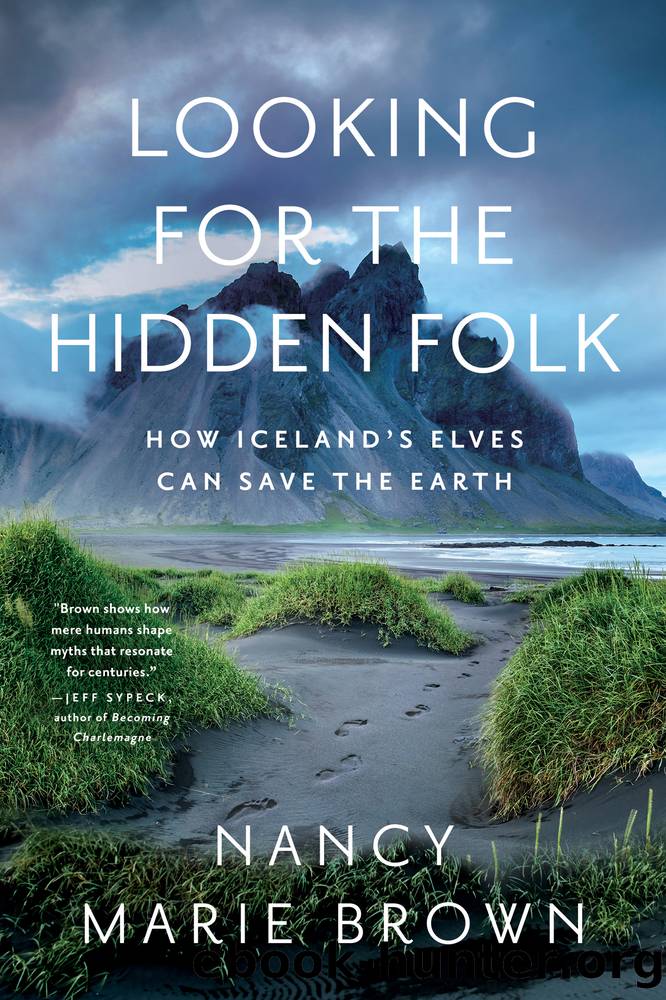Looking for the Hidden Folk by Nancy Marie Brown

Author:Nancy Marie Brown
Language: eng
Format: epub
Publisher: Pegasus Books
Published: 2022-10-04T00:00:00+00:00
Doors
Without my glasses on the other day I saw a headline that said Books, and I read Doors. Iâm not sure I was wrong. Some books, wrote J. R. R. Tolkien, âopen a door on Other Time, and if we pass through, though only for a moment, we stand outside our own time, outside Time itself, maybe.â
The Book of Land-Taking opens such a door. Written in Iceland in the early 1100s, itâs not a saga; itâs a collection of notes: outlines, episodes, anecdotes. It names some 3,500 people and 1,500 farms, progressing clockwise around the country. It reads as factâlong genealogies, places still on the mapâexcept when sorcerers, shapeshifters, and seers appear.
Their taste for fantasy hasnât tarnished the bookâs authors: Ari the Learned and Kolskegg the Wise are accounted as Icelandâs first historians. Nor did the fantastic alarm the later scholars who copied The Book of Land-Taking and preserved it down to our time: not Styrmir, whose copy from before his death in 1245 is now lost; not Sturla, whose manuscript made before 1284 was copied onto paper in the 1600s and then lost; not Haukur, whose 1306 manuscript only has fourteen out of thirty-eight leaves remaining; not the anonymous scribe who made a copy in the 1400s (two leaves remaining); not Bjorn, who used vellum manuscripts of Sturlaâs and Haukurâs books to make his own before he died in 1655âit was copied onto paper before the original burned in 1728; not even Thordur, whose manuscript from before 1670 still survives in Icelandâs national library. Each retained the fairy tales.
My favorite is the story of a horse race. In the mid-900s, a Viking ship carrying a cargo of livestock beached at Kolkuos, the conjunction of two river mouths in northern Iceland. As they were offloading, one horse escaped. A man called Thorir Dove-Nose bought the right to keep the mare, if he could catch her, and he did. He named her Fluga (Fly), for she was very fast.
Thorir Dove-Nose was a braggart, as well as beak-nosed, for a sorcerer named Orn soon got wind of Fly. Orn waylaid Thorir one summer night in the center of Iceland, on a black sand desert between the high glaciers, as Thorir was heading south to the Althing, the yearly meeting of Icelandâs chieftains at Thingvellir.
Today Thingvellir is known to be a rift zone bridging two tectonic plates. To the Viking settlers it was a wide wooded valley with a fast-running river and a fish-filled lake, conveniently near the major routes through Icelandâs uninhabitable highlands. Riding from north, south, east, and west, some on the road for two weeks or more, the chieftains brought sail cloth to roof turf-walled booths and settled in to legislate. The lawspeaker, Icelandâs only government official, stood on a hilltop (the Law Rock) reciting the laws; the basalt rift wall rising behind him, like an acoustic shell, amplified his voice. The chieftains and their followers, on the slope below, agreed or raised legal challenges. Judges chosen by the chieftains settled lawsuits in four courts, one for each quarter of the country.
Download
This site does not store any files on its server. We only index and link to content provided by other sites. Please contact the content providers to delete copyright contents if any and email us, we'll remove relevant links or contents immediately.
Spell It Out by David Crystal(35348)
Underground: A Human History of the Worlds Beneath Our Feet by Will Hunt(11261)
A Year in the Merde by Stephen Clarke(4658)
Venice by Jan Morris(2051)
Claridge's: The Cookbook by Nail Martyn & Erickson Meredith(1963)
My Paris Kitchen: Recipes and Stories by Lebovitz David(1893)
A TIME OF GIFTS by Patrick Leigh Fermor(1849)
The Plantagenets by Dan Jones(1617)
Welcome to the Goddamn Ice Cube by Blair Braverman(1601)
Bang Poland: How To Make Love With Polish Girls In Poland by Roosh V(1590)
Top 10 Prague (EYEWITNESS TOP 10 TRAVEL GUIDES) by DK(1569)
From Russia with Lunch by David Smiedt(1551)
The Finnish Way by Katja Pantzar(1537)
The Isle of Mull by Terry Marsh(1520)
A TIME TO KEEP SILENCE by Patrick Leigh Fermor(1499)
Rick Steves London 2018 by Rick Steves & Gene Openshaw(1494)
A Taste of Paris by David Downie(1491)
Merde in Europe by Stephen Clarke(1436)
Insight Guides Experience Tokyo by Insight Guides(1419)
